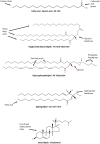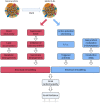Relationship between lipoproteins, thrombosis, and atrial fibrillation
- PMID: 33483737
- PMCID: PMC8859639
- DOI: 10.1093/cvr/cvab017
Relationship between lipoproteins, thrombosis, and atrial fibrillation
Abstract
The prothrombotic state in atrial fibrillation (AF) occurs as a result of multifaceted interactions, known as Virchow's triad of hypercoagulability, structural abnormalities, and blood stasis. More recently, there is emerging evidence that lipoproteins are implicated in this process, beyond their traditional role in atherosclerosis. In this review, we provide an overview of the various lipoproteins and explore the association between lipoproteins and AF, the effects of lipoproteins on haemostasis, and the potential contribution of lipoproteins to thrombogenesis in AF. There are several types of lipoproteins based on size, lipid composition, and apolipoprotein category, namely: chylomicrons, very low-density lipoprotein, low-density lipoprotein (LDL), intermediate-density lipoprotein, and high-density lipoprotein. Each of these lipoproteins may contain numerous lipid species and proteins with a variety of different functions. Furthermore, the lipoprotein particles may be oxidized causing an alteration in their structure and content. Of note, there is a paradoxical inverse relationship between total cholesterol and LDL cholesterol (LDL-C) levels, and incident AF. The mechanism by which this occurs may be related to the stabilizing effect of cholesterol on myocardial membranes, along with its role in inflammation. Overall, specific lipoproteins may interact with haemostatic pathways to promote excess platelet activation and thrombin generation, as well as inhibiting fibrinolysis. In this regard, LDL-C has been shown to be an independent risk factor for thromboembolic events in AF. The complex relationship between lipoproteins, thrombosis and AF warrants further research with an aim to improve our knowledge base and contribute to our overall understanding of lipoprotein-mediated thrombosis.
Keywords: Atrial fibrillation; Haemostasis; High-density lipoprotein; Incidence; Lipids; Lipoprotein(a); Lipoproteins; Low-density lipoprotein; Oxidized lipoprotein; Stroke; Thromboembolism; Thrombosis; Very low-density lipoprotein.
© The Author(s) 2021. Published by Oxford University Press on behalf of the European Society of Cardiology.
Figures




References
-
- Chugh SS, Havmoeller R, Narayanan K, Singh D, Rienstra M, Benjamin EJ, Gillum RF, Kim Y-H, McAnulty JHJ, Zheng Z-J, Forouzanfar MH, Naghavi M, Mensah GA, Ezzati M, Murray CJL.. Worldwide epidemiology of atrial fibrillation: a Global Burden of Disease 2010 Study. Circulation 2014;129:837–847. - PMC - PubMed
-
- Benjamin EJ, Wolf PA, D’Agostino RB, Silbershatz H, Kannel WB, Levy D.. Impact of atrial fibrillation on the risk of death: the Framingham Heart Study. Circulation 1998;98:946–952. - PubMed
-
- Stewart S, Hart CL, Hole DJ, McMurray JJ.. A population-based study of the long-term risks associated with atrial fibrillation: 20-year follow-up of the Renfrew/Paisley study. Am J Med 2002;113:359–364. - PubMed
-
- Thrall G, Lane D, Carroll D, Lip GYH.. Quality of life in patients with atrial fibrillation: a systematic review. Am J Med 2006;119:448.e1–448.e19. - PubMed
-
- Vermond RA, Geelhoed B, Verweij N, Tieleman RG, Van der Harst P, Hillege HL, Van Gilst WH, Van Gelder IC, Rienstra M.. Incidence of atrial fibrillation and relationship with cardiovascular events, heart failure, and mortality a community-based study from the Netherlands. J Am Coll Cardiol 2015;66:1000–1007. - PubMed
Publication types
MeSH terms
Substances
LinkOut - more resources
Full Text Sources
Other Literature Sources
Medical

